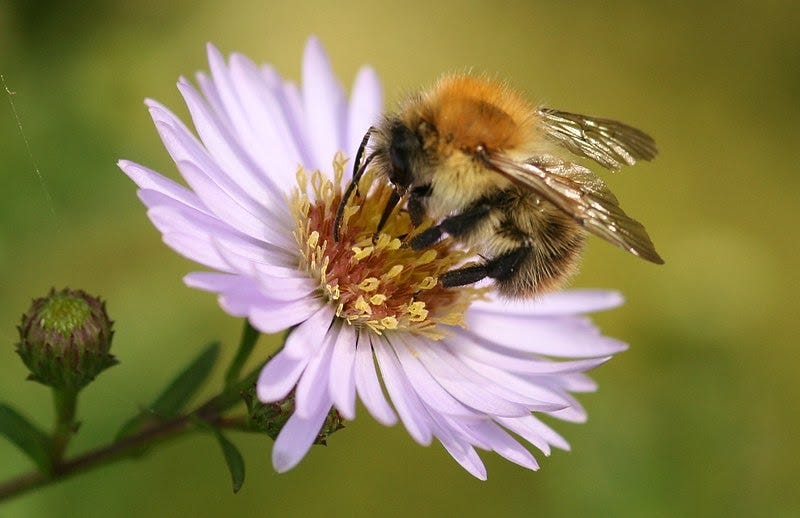The expression “the bees’ knees,” meaning something like “fantabulous,” became popular in the 1920s. It co-evolved with “the cat’s pajamas.” Apparently both knees and pajamas were considered racy then, so using those terms was a crackerjack way for young folk to shock their parents.
Other superlatives that floated in that era were “the flea’s eyebrows,” “the canary’s tusks” and “the snake’s hips.” I’m a little bit sorry those gems haven’t stuck around.
Honey Bees vs. Native Bees
Bees have been in the news a lot over the past couple of decades. You’ve undoubtedly seen alarming headlines about colony collapse disorder. Here’s the thing, though: most of this attention has been focused on honey bees, which are not native to North America — they’re originally from Eurasia — and are basically winged livestock used to produce a liquid sweetener (an admittedly delicious one) and pollinate a relatively small portion of our agricultural crops.
Yes, pollination is critical: 80% of all plants and 90% of all flowering plants depend on pollinators to perpetuate their species. I love me some honey, but the pollinators we really need to worry about are the indigenous ones, including 4000 species of native bees. Those are the insects doing the heavy pollination lifting in North America.
A Quick Primer on Native Bees
Native bees come in all shapes and sizes and include bumble bees, carpenter bees, mason bees, squash bees, cuckoo bees, miner bees, and the very chic-looking, iridescent sweat bees, among many others.
Ninety percent of native bees are solitary. They’re herbivores and they don’t have hives to defend, so they’re not aggressive. Word on the street is that you can pet a bumble bee while it’s buzzing about and it won’t sting you. I haven’t tried this myself, but let me know how it goes if you do!
Native bee populations are declining rapidly, due to pesticides, habitat loss, nonnative and invasive species, security lights and climate change. Competition from honey bees may also be part of the problem.
50% of midwestern native bee species have disappeared
25% of bumble bee species are at risk of extinction and three species are already presumed extinct
Four bumble bee species have declined 96% in the last 20 years
So it’s very much in our interest to make native bees feel at home in our yards.
Unlike honey bees, the native species mostly live either in little tunnels they dig into the ground or in woody or pithy (spongy) stems. So if you have a yard, leave some patches of soil -- ideally on sunny south-facing slopes -- clear of mulch and heavy vegetation. Also, resist the temptation to cut down dead flower stalks; those are prime native bee real estate. Leave the stalks up over the winter. In the spring you can cut them back, leaving about 8-10” above ground, which will quickly be overtaken by new growth. If you’re ambitious, you can make or buy your own bee hotels. (Stay tuned for more on those in a future installment of The Bees’ Knees.)
You’ll also want to provide food sources from March through November. This means a succession of flowers that provide nectar and pollen. Unlike honey bees, many native bees are specialists -- they can forage on only one or a few species of flowers. If you plant for the specialists, you’ll satisfy the picky eaters as well as the generalists. Some of the best plants for bee specialists are sunflowers, asters, goldentops, goldenrods, evening primroses, willows, false indigos, black-eyed susans, fleabanes and violets.
About Those Knees
And finally, the answer you’ve been patiently awaiting. I regret to inform you that fleas do not have eyebrows, canaries do not have tusks, snakes do not have hips, and only a few very special cats have pajamas. But the bees, they do have knees! Six of ‘em!
Need I say more about the naming of this newsletter?
If you know someone(s) who might be interested, please feel free to share this post.
Resources:
Beatriz Moisset and Stephen Buchmann, Bee Basics: An Introduction to Our Native Bees, A USDA Forest Service and Pollinator Partnership Publication
The Little Things That Run the World by Doug Tallamy, Guelph Garden Seminars, May 14, 2021
Krisy Gashler, “Native Bees Are Better Pollinators, More Plentiful than Honeybees, Finds Entomologist,” Cornell Chronicle, October 24, 2011
Chris Helzer, “Focus on Native Bees, Not Honey Bees,” Cool Green Science, August 19, 2019
Alison McAfee, “The Problem with Honey Bees,” Scientific American, November 4, 2020
Luis Villazon, “Do Bees Have Knees and If So, What’s So Special About Them?” BBC Science Focus Magazine







I believe this is why a wise person told me not to worry about those “ground bees” that appear in my front yard periodically every Spring. I will now welcome them!!